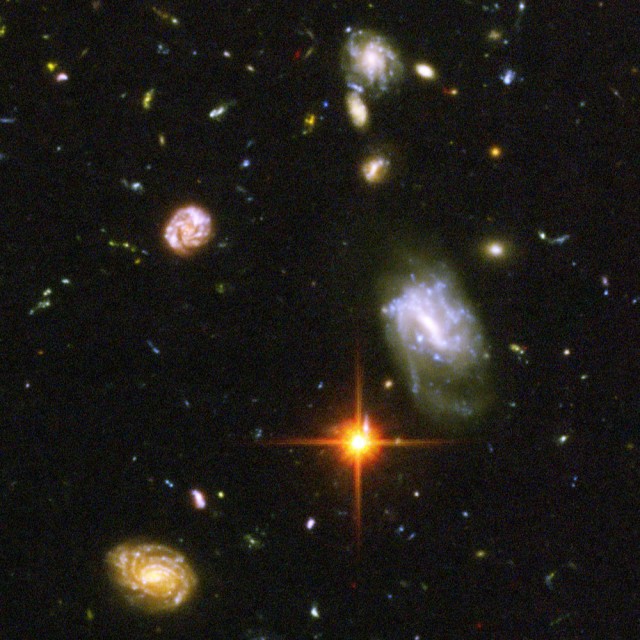
In astronomy, there's a regular flow of oldest (and thus most distant) objects—galaxies, supernovae, quasars, and so on. In most cases, these objects are enough to make jaws drop due to the prodigious amount of energy that had to be released in order for them to be visible across most of the unknown Universe. The findings really don't tell us much until they're aggregated, however, because it's hard to infer too much about the early Universe from a single object
For that reason, I didn't pay careful attention last week when astronomers announced the discovery of the most distant galaxy yet observed, present when the Universe was just 700 million years old. But as I got a chance to read the paper over the weekend, I realized there was more to the story than just the age. Because of the method used to discover the galaxy, the researchers were able to learn some things about whether we're likely to be able to image other ancient galaxies. And the object itself has some interesting properties that suggest other early galaxies might be poised for sudden bursts of star formation.
The discovery relies on emissions from hydrogen atoms that occur when an energetic electron falls back to the ground state. One of the main forms of this emission, the Lyman-a line, starts off in the UV end of the spectrum. But as it travels across the Universe, the light becomes red-shifted. For the earliest galaxies, this red shift is so strong that the photons end up down in the infrared area of the spectrum. The authors surveyed 43 old-looking galaxies, searching for ones where the emissions were shifted the deepest into the infrared.
They came up with only one that had a clear indication of hydrogen emissions in the right area of the infrared. And that's odd. Statistically, you'd expect a more even mix of older and younger galaxies in a population of 43. The authors therefore conclude that "some process is making Lyman-a difficult to detect." They seem to think that there's probably too much neutral hydrogen around, which will reverse the process and reabsorb the hydrogen emissions, gradually scattering them. This means that spotting other very early galaxies will be very challenging.
This situation isn't a problem in the current Universe, because there are so many energetic events that any hydrogen is ionized. But if it was an issue at this early phase, then it raises the question of how this galaxy ended up visible.
The answer brings us to an interesting property of the galaxy: a staggeringly high rate of star formation. The apparent rate of star formation in this galaxy is over 100 times that of the Milky Way and over 30 times what you might see in galaxies undergoing rapid star formation. This thing is forming new stars at a furious rate.
Another surprising finding is that the galaxy has a surprising amount of heavier elements already—about 30 percent of those seen in our Sun. Since these elements only form in the explosions of stars, it suggests that an early round of star formation and destruction had already taken place less than 700 million years after the Big Bang.
The authors manage to tie all of this together into a neat picture. The heavier elements actually make star formation easier, as they help radiate away the initial energy from the gravitational collapse of a star. In the earliest stages of this galaxy's formation, very shortly after the Big Bang, it had none, which allowed gravity to pull together enormous amounts of gas before the first stars managed to form. In the absence of metals, these stars were large and unstable, and they exploded relatively quickly, which rapidly got the galaxy's content of heavier elements up to relatively high levels.
These heavier elements made further star formation easier, and thus set off the amazing burst of star formation. In turn, that star formation ionized the thick cloud of gas in and around the galaxy itself, allowing light to escape.
It's a great story, and it all makes scientific sense. The problem is that, as noted above, we only have a single example. Until we can find more—and it looks like we may have to look at a lot of ancient galaxies to see more—it's hard to tell how plausible this model is.
Nature, 2013. DOI: 10.1038/nature12657 (About DOIs).
reader comments
19